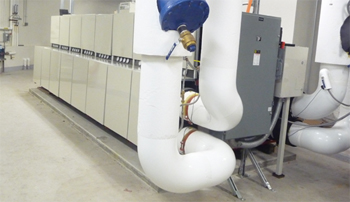Last year, UNMC installed new reheat chillers in the Durham Research Center towers that are more energy and cost efficient than previous chillers.
 Below, Rick Kmiecik, UNMC’s director of strategic energy initiatives, discuss the new chillers and how they help UNMC and the planet.
Below, Rick Kmiecik, UNMC’s director of strategic energy initiatives, discuss the new chillers and how they help UNMC and the planet.
What do reheat chillers do and how do they work?
 |
These reheat chillers in the Durham Research Center recycle their own heat byproduct in other areas of the building. Typically such byproducts are simply ejected into the atmosphere. A similar chiller system is active in the Durham Research Center II. |
How do they benefit UNMC’s sustainability efforts?
These dedicated heat recovery chillers do not “waste” energy as a byproduct like typical chillers and boilers do. The operation of these chillers will not only save energy on a daily operating basis but will help supplement the much needed infrastructure of the campus to help keep up with the growing demand.
|
There are eight units in Durham Research Center and six units in Durham Research Center II.
What is the cost benefit of the reheat chillers?
We are saving between $60 and $70 per hour of operation. That may not sound like a lot but understand that they operate at all times, which equates to approximately $600,000 per year of savings. The equipment purchase and installation was $1.3 million giving the overall project a payback period of slightly more than two years.